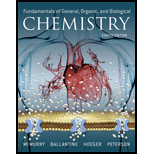
Concept explainers
Interpretation:
The reason should be explained for the formation of the unexpected product 2-methyl-
2-pentene on dehydration of 4-methyl-2-pentanol.
Concept Introduction:
Dehydration reaction:
Removal of water molecule from the reaction when the alcohol is treated with strong acid like sulfuric acid.

Alcohol is reaction with concentrated sulfuric acid, first alcohol gets protonated forms carbocation (more stable carbocation) followed by elimination of proton (
Tertiary carbocation is more stable than the secondary, secondary carbocation is more stable than primary.

In dehydration reaction, sulfuric acid is act as a proton donor, and which is used to protonate the alcohol and makes carbocation therefore sulfuric acid is the driving force of the reaction.
Want to see the full answer?
Check out a sample textbook solution
Chapter 14 Solutions
Pearson eText Fundamentals of General, Organic, and Biological Chemistry -- Instant Access (Pearson+)
- a) 2-Hydroxy-carboxylic acids in the citric acid cycle and in glycolysis (3 answers): b) how do the ring systems in tryptophan (indole ring) and in histidine (imidazole ring) fulfill the Hückel rule? c) How does the aromatic state affect the basicity of the ring nitrogens?arrow_forwardIn solution, glucose exists predominantly in the cyclic hemiacetal form, which does not contain an aldehyde group. How is it possible for mild oxidizing agents to oxidize glucose?arrow_forwardDraw the structure of two different aldohexoses that yield the followingaldaric acid when oxidized with HNO3. Use Figure to name eachaldohexosearrow_forward
- The enzyme Glucose-6-phosphate dehydrogenase catalyzes the nicotinamide adenine dinucleotide oxidation of cyclic glucose-6-phosphate to form the lactone product shown below. Propose a mechanism for this reaction showing all electron flow (using the arrow convention). You must draw the substrate glucose-6-phosphate (the configuration of the anomeric carbon does not matter) and the “business end” of the cofactor.arrow_forwardWhat disulfides would you obtain from oxidation of the following thiols?(a) CH3CH2CH2SH (b) 3-Methylbutane-1-thiol (skunk scent)arrow_forwardName, draw and describe the organic product of the reaction between 2-methylbut-1-ene and H2O in the presence of H2SO4 and provide a clear rationale as to why this is the major product of the reaction.arrow_forward
- With alanine AA, and using citric acid cycee and glycolysis, which Carbon atom would be labeled 1st with 14C n succinate? Why?arrow_forwardA reaction involved in the metabolism of sugars is the splitting of fructose-1,6-diphosphate to give glyceraldehyde-3- phosphate and dihydroxyacetone phosphate. In the living system, this retro-aldol is catalyzed by an enzyme called aldolase; however, it can also be catalyzed by a mild base. Propose a mechanism for the base-catalyzed reaction. CH,-0-P-0- CH,-0-P-0- C=0 C=0 CH,OH dihydroxyacetone phosphate HO-C-H aldolase or "OH H-C-OH H-C-OH H-C-OH CH,-0-P-0- CH2-0-P-0- fructose-1,6-diphosphate glyceraldehyde-3-phosphatearrow_forwardStearidonic acid (C18H28O2) is an unsaturated fatty acid obtained from oils isolated from hemp and blackcurrant (see also Problem 10.11). a. What fatty acid is formed when stearidonic acid is hydrogenated with excess Hạ and a Pd catalyst? b. What fatty acids are formed when stearidonic acid is hydrogenated with one equivalent of Hz and a Pd catalyst? c. Draw the structure of a possible product formed when stearidonic acid is hydrogenated with one equivalent of H2 and a Pd catalyst, and one double OH stearidonic acid bond is isomerized to a trans isomer. d. How do the melting points of the following fatty acids compare: stearidonic acid; one of the products formed in part (b); the product drawn in part (c)?arrow_forward
- Identify any combination reactions. (Select all that apply.) C4H10 + O2 → CO2 + H2O S8 + O2 → SO3 NaNO3 → NaNO2 + O2 HgO → Hg + O2 Ga + H2SO4 → Ga2(SO4)3 + H2 AgCl2 + H2 → Ag + HCl none of the above Identify any decomposition reactions. (Select all that apply.) C4H10 + O2 → CO2 + H2O S8 + O2 → SO3 NaNO3 → NaNO2 + O2 HgO → Hg + O2 Ga + H2SO4 → Ga2(SO4)3 + H2 AgCl2 + H2 → Ag + HCl none of the abovearrow_forwardSome diazotrophs produce a vanadium-containing VFe protein in addition to the MoFe protein. The vanadium-containing nitrogenase converts N2 to NH3 and also converts CO to compounds such as ethane and propane. What aspect of the standard nitrogenase reaction is responsible for the production of alkanes?arrow_forwardLithium ion inhibits the synthesis of inositol trisphosphate by inhibiting a reaction in the breakdown of inositol trisphosphate. Explain this apparent paradox.arrow_forward
 BiochemistryBiochemistryISBN:9781319114671Author:Lubert Stryer, Jeremy M. Berg, John L. Tymoczko, Gregory J. Gatto Jr.Publisher:W. H. Freeman
BiochemistryBiochemistryISBN:9781319114671Author:Lubert Stryer, Jeremy M. Berg, John L. Tymoczko, Gregory J. Gatto Jr.Publisher:W. H. Freeman Lehninger Principles of BiochemistryBiochemistryISBN:9781464126116Author:David L. Nelson, Michael M. CoxPublisher:W. H. Freeman
Lehninger Principles of BiochemistryBiochemistryISBN:9781464126116Author:David L. Nelson, Michael M. CoxPublisher:W. H. Freeman Fundamentals of Biochemistry: Life at the Molecul...BiochemistryISBN:9781118918401Author:Donald Voet, Judith G. Voet, Charlotte W. PrattPublisher:WILEY
Fundamentals of Biochemistry: Life at the Molecul...BiochemistryISBN:9781118918401Author:Donald Voet, Judith G. Voet, Charlotte W. PrattPublisher:WILEY BiochemistryBiochemistryISBN:9781305961135Author:Mary K. Campbell, Shawn O. Farrell, Owen M. McDougalPublisher:Cengage Learning
BiochemistryBiochemistryISBN:9781305961135Author:Mary K. Campbell, Shawn O. Farrell, Owen M. McDougalPublisher:Cengage Learning BiochemistryBiochemistryISBN:9781305577206Author:Reginald H. Garrett, Charles M. GrishamPublisher:Cengage Learning
BiochemistryBiochemistryISBN:9781305577206Author:Reginald H. Garrett, Charles M. GrishamPublisher:Cengage Learning Fundamentals of General, Organic, and Biological ...BiochemistryISBN:9780134015187Author:John E. McMurry, David S. Ballantine, Carl A. Hoeger, Virginia E. PetersonPublisher:PEARSON
Fundamentals of General, Organic, and Biological ...BiochemistryISBN:9780134015187Author:John E. McMurry, David S. Ballantine, Carl A. Hoeger, Virginia E. PetersonPublisher:PEARSON





